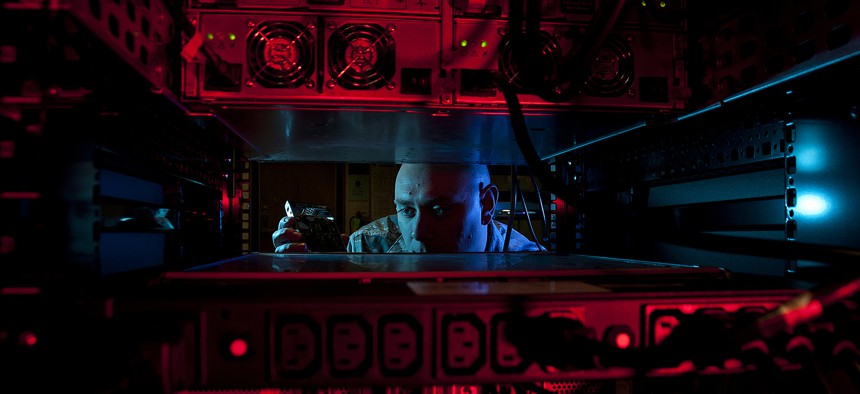
U.S. Air Force Staff Sgt. Jerome Duhan, a network administrator, inserts a hard drive into the network control center retina server at Altus Air Force Base in preparation for a command cyber readiness inspection. DoD photo by Senior Airman Franklin R. Ramos, U.S. Air Force
A Top-Secret Cell Phone Is Just One New Tool the Pentagon Can Expect Soon
In a call with reporters, the Defense Department's chief information officer shared a handful of new developments on the Pentagon's tech horizon.
The Defense Department made news this spring when Ash Carter became the first defense secretary in almost 20 years to visit Silicon Valley. In a media call Tuesday, Pentagon Chief Information Officer Terry Halvorsen told a handful of reporters what the Pentagon plans to learn from the private sector -- including technology that could automate cyber response -- and also provided updates on a plan to outfit parts of the Pentagon with Wi-Fi.
Here are a few takeaways from that conversation:
1. Sometime in the fall, DOD plans to test out smartphones that can access top-secret information.
Halvorsen confirmed DOD is deploying the top-secret smartphones in the fall, but declined to provide any more detail on the efforts because, he said, "I don't want people to know when we're actually going live with those." He added that the Pentagon has already done some preliminary testing on the phones and is "continuing to see great results on that."
2. By the end of fiscal year 2016's first quarter, DOD plans to deploy civilian employees into Silicon Valley for 6-month rotations, Halvorsen said.
This program, modeled after another program that sends military employees for year-long rotations in the private sector, is part of a series of efforts to connect with Silicon Valley tech talent, including a new Pentagon outpost in California, as well as $75 million investment in a coalition of companies and universities working on flexible and wearable electronic devices.
3. DOD is trying to adapt private sector cyber technology.
The Pentagon is paying attention to cyber solutions offered by startups, Halvorsen said. "Many times they may have really good ideas, but in their initial format they just don't scale," he said. "What I'm working with Silicon Valley on, and what we're trying to [find out] is 'where do we do the testing to see if they will scale? First of all, where do we test to see if they really will work?'" He added the Pentagon wants to be able to complete pilot programs and tech experiments faster. "But we also need Silicon Valley to be able to understand that when you can field a tool for 5,000 to 10,000 people, and there's a market for that, I am not the market for that," Halvorsen said. " What I need to look at has to be able to scale to millions of people."
DOD also wants to automate cyber defense. For now, officials are looking at the basics, such as automatically patching updates. "At a certain point, I want to be able to have some cyber defense completely automated where a certain set of conditions occur, and the system takes its own response," Halvorsen added.
The Pentagon is keeping pace with Fortune 50 companies in terms of cloud adoption, Halvorsen said.
Commercial companies are using private and commercial, just as DOD is, he said. "We're all trying to find what is going to be that hybrid sweet spot, and how much [data] do you put out there," he said.
Within DOD, as in the private sector, there isn't going to be "one cloud answer . . . there's going to be some stuff that goes into a perfectly commercial cloud, that'll work," he said. "There are going to be things that go into a hybrid cloud where it might be a partnership with the . . . federal government and DOD, maybe federal [and] state governments."
An incident in which computers in Pentagon's food court were hacked, potentially exposing employee information, isn't really the DOD CIO's problem.
“If the food court was hacked, that would not be the DOD that was hacked," Halvorsen said, adding that he did not have any more data about the incident.
But he said that plans to install Wi-Fi, including a guest network, in the Pentagon are moving forward and the network is on track to be operational by the end of December. The department is prioritizing major meeting areas and some common spaces. "The key part for us is having all of the sensors in place to assure me that I am using Wi-Fi in all the right ways, and then when I want to say, 'OK, now turn off the Wi-Fi because I'm doing something else,' I can be assured that the Wi-Fi is off," he said.




